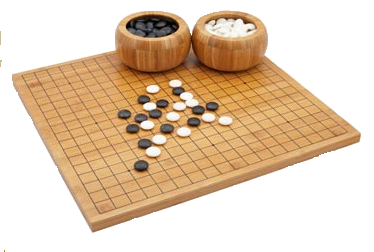Minimal Groups
First, some very basic and important stuff. If a group has only one empty intersection on the inside, when the outside liberties are filled, the group is under atari, and may be captured. I don't think you need a diagram for that.Next, if a group has only two empty intersections next to each other on the inside, when the outside liberties are filled, the opponent can play inside the group, leaving only one liberty and the group can be killed.
Why is this important? If you can attack and change any interior group into a group of two, you can kill it.
The rest of this section will be concerned with interior groups larger than two.
Smallest living shapes
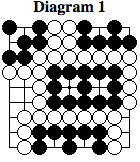
There is a very important point to be made here. The smallest group requires 6 stones. [Look at the two black groups at the top.] Next time you invade your opponent's territory ask yourself if you have enough room to build such a group. Then ask yourself whether your opponent is liable to sit back and let you. You may save yourself some grief.
This also leads to another interesting question: how do you build such a group? For example, consider the next diagram:
A group of 3 can be killed.
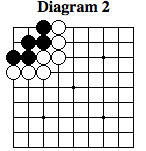
Black can play in the corner and make the Minimal group, but what if it is White's turn? If White plays in the corner, Black can never make two separate eyes, so remember that with a group having only three interior intersections (call it a group of 3) whoever plays first will win. If Black plays first the group is alive; if White plays first the group is dead. Some people don't believe this at first - so let's prove that White can kill it by playing inside. First what happens if Black tries to capture that stone by playing as in Diagram 3b?
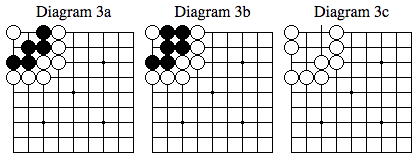
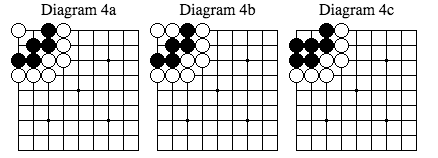
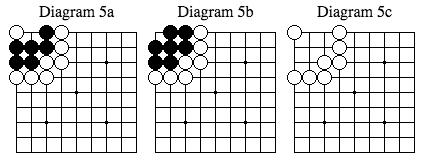
[You may have noticed that things might be different if the white group on the outside was itself surrounded by Black. I don't want to get into more advanced analysis yet, but in the above diagrams, it was always assumed that the white group was safe from capture.]
If you did not know about this before, you have just learned a very important thing about life and death in Go. Let's spell it out
|
A group of 3 can be killed. |
Why is that? Because it can be reduced to a group of two (see above). The attacker doesn't have to play on the centre point, any play reduces to a group of two.
There's another part to this story:
|
A group of 3 can be saved. |
You may be surprised by how often this comes up, especially in fights involving the corners. Remember, this applies to any group of three, whether the three are arranged as shown here, or three in a straight line. So learn it once and for all, and look ahead. If you see your group can only become a group of three, think twice before you continue with it
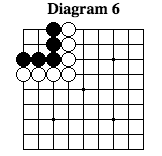
4 in a box is dead.
It would seem logical that if a group of 3 can be killed, a group of 4 must be safe, but that is not always so. If the four intersections are in a box, as in diagram 6, they are always dead, no matter what Black does.
You can probably see that White can kill the group if it is White's move,
by playing inside untill all the liberties are filled. But if Black goes first,
what can he do? The only thing he can do is change the shape from four in a box to 3, like
these two diagrams...
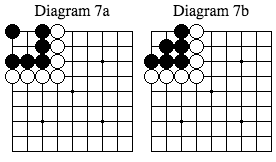
..and we already know that a group of 3 can be killed. (Remember it is White's turn now, so the Black group will die.)
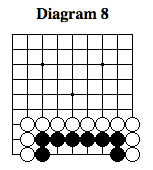
4 in a straight line is alive.
There are, of course, several ways that four intersections can be arranged inside a group. Here is another that is always alive, even if the opponent plays first.
Wherever White plays, Black can play to ensure that there will always be 2
eyes. You might want to prove that to yourself, as a little problem.
Remember, Black does not have to play first to save this group - it is alive as it stands. Now, if 4 in a straight line is always alive, then any number larger than 4 in a straight line must also be alive.
Other groups of 4.
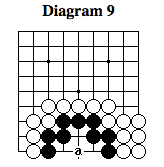
There are still three other ways that 4 in a group can be arranged, and here they are. The first one is sometimes called "4 in a pyramid" and can be killed if the opponent gets to play at 'a' first. This is very similar to the 3 in a group case, but here there is one key point ('a') that determines the life and death of the group according to whoever plays there first.
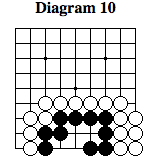
The next one might be called four in a line with a zig-zag. It is just like
the 4 in a straight line case. Black does not have to play, and White cannot
kill it. Try for yourself.
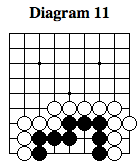
Finally there is 'bent four'.It looks the same as the previous case, and it is most of the time, but there is one special case - known as "bent 4 in the corner" - and there have probably been more arguments about this shape than any other in the game.
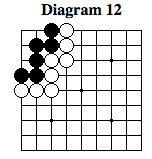
Here is what bent 4 in the corner looks like.
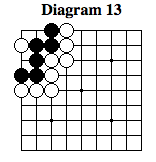
Obviously if Black plays first he can make 2 eyes. The question is: what happens if White plays first?
Clearly, if Black does nothing, White can kill the group by playing in the corner and taking away the possibility of two eyes. So Black has to play the corner, White takes that stone and a ko fight starts.
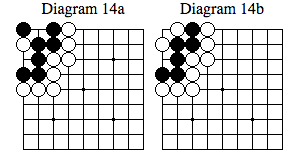
If you don't understand Ko fights yet, don't worry about it - just remember that bent 4 is the corner is not always alive forever. Some people will tell you that "bent 4 in the corner is dead," which is actually a rule in Japanese Go ( not in Chinese). This is true of certain variations, but not of every one. If in doubt you can always play it out...
[The best discussion of this complicated issue may be in chapter 16 of James Davies' book "Life and Death", Ishi Press, 1975]
Groups of 5.
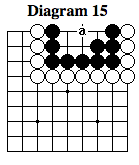
You should be able to guess that most 5
shapes are alive, because most 4 shapes are. There are two 5 shapes that can be
killed however. The first one can be killed because it may be reduced to one of
the two dead shapes we have already seen.
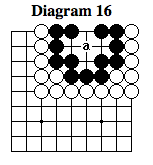
The key point, is 'a'. If Black can play there first the troubles are over,
because that makes 2 eyes. But if White plays there first, there is nothing to
be done. White can either make the shape into 4 in a box or four in a triangle,
no matter what Black does. But the most important part is that White has
prevented Black from forming two eyes, so Black must die. This shape is
sometimes called "bulky five," and often comes up in corner play.
I hope you can see by now that the point 'a' is the only point that will
allow Black to make two eyes (actually 4 eyes in this case) and that White can
kill the group by playing there.
Groups of 6.
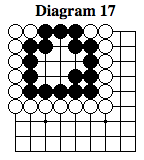
[If you can't see the rabbit's head don't worry, but the face is the four in a box, and the two ears are the two other points. So it is slanted at a 45 degree angle.] This shape also has a key point that will allow Black to make two eyes (actually 3) and will allow White to kill unconditionally. If you can't spot this point on your own, read the rest of the page again until it becomes clear.
